Abstract
The problem of desertification in the Tarim Basin, an area with a unique geography and climatic conditions, has received extensive research attention not only in China but also around the world. Between natural factors and human activities, the latter are considered the main cause of desertification, with the excessive use of land resources accelerating its risk. This study classified the degree of desertification into five types, no, light, moderate, severe, and extremely severe desertification, and focused on the spatio-temporal changes in LULC, desertification development, and their relationship in the Circum-Tarim Basin during the period of 1990–2020, and the results indicated the following. (1) Over the 30-year study period, farmland development was frequent in the basin. The total farmland area increased significantly by 1.40 × 104 km2, which resulted from the occupation of grassland (mainly low-covered and medium-covered grassland) and unused land (mainly saline–alkali land). (2) There was a general alleviation of the effects of desertification, but also local deterioration. The area of no-desertification land has significantly increased (an increase of 2.10 × 104 km2), and the degree of desertification has shifted significantly to adjacent lighter degrees, but the area of extremely severe desertification in certain regions has increased (an increase of 7.89 × 104 km2). (3) There was an inseparable relationship between LULC and desertification. Oasisization and desertification were two processes that interacted and were interrelated. There was an approximately 54.42% increase in no-desertification land area mainly occurring in the region where LULC types changed (Region II), although this area only accounted for 9.71% of the total area of the basin. There was an approximately 98.28% increase in the area of extremely severe desertification occurring where there were no changes in LULC types (Region I). Region II demonstrated the best effects of desertification prevention and control in the 30-year study period in the Circum-Tarim Basin. Land development and oasis expansion have led to concentrated water use, resulting in water scarcity in certain areas, which cannot support the needs of vegetation growth, thus aggravating the degradation. Hence, “adapting measures to local conditions, rational planning, zoning policies, precise prevention and control” will be the way forward for desertification control in the future in the Circum-Tarim Basin.
1. Introduction
Desertification can be defined as land degradation in arid, semi-arid, and dry subhumid areas due to the negative impacts of human activities and climatic variations [1], and it seriously affects and disturbs the survival and sustainable development of human society [2]. Indeed, desertification is one of the most serious ecological and environmental problems in the world. The total area of global drylands accounts for around 41.00% of the Earth’s land surface and is home to more than 38.00% of the global population (6.5 × 109 in 2013) [3]. Desertification could bring various negative consequences, such as the loss of soil resources, increased soil salinity and toxicity, changes in vegetation composition, and so on [4,5,6], thus further affecting the beautiful home on which humanity relies for survival [7,8]. In the early 1990s, the United Nations Convention to Combat Desertification Conference on Desertification focused global attention on combating desertification [2]. In the 21st century, the Millennium Ecosystem Assessment was launched in 2001, and the 2030 Agenda for Sustainable Development was established by the UN in 2015. Both of these efforts emphasized the importance of linking the ecosystem services provided by deserts and desertified land to human well-being [9,10,11].
The occurrence and development of desertification are accompanied by the history of human civilization, and the human–land system formed by the interaction between human activities and the natural environment is largely reflected in the mode and extent of human use of land [12]. For most of the history of human civilization, natural resources and the environment have determined the mode of land use. However, in the modern era, due to the increase in the world population and the progress of science and technology, the demand for the utilization of natural resources has increased sharply, and the subjective initiative and regulation of human activities have been enhanced in the human–earth relationship. In many cases, this represents an advance in the efficient use of resources. However, the unreasonable use of resources and the environment affects the process of changes in resources and the environment to varying degrees, causing or even controlling adverse gradients or mutations in resources and the environment, such as increased greenhouse gas emissions [13], river cutoff [14], and soil erosion [15]. Desertification is a more obvious example, and land and its related issues have always attracted great concern. As early as the 1920s, when conducting research on the agricultural society of the Great Plans in the United States, Webb [16] pointed out that land use types were determined by the degree of local drought. This is the earliest known exploration of land use processes and change mechanisms from a socio-economic perspective without considering other human factors [17]. In the century since, the impact of human activities on land degradation due to changing surface vegetation, land use types, and other factors has been a constant focus of exploration. There is research highlighting that unreasonable land use puts desertification in the process of development [18,19,20,21], and rational and efficient land use is the fundamental solution to achieving sustainable development and desertification prevention in affected areas [22]. Therefore, studies around the world have summarized many successful experiences in desertification prevention and control [23,24,25], especially in China, where numerous cases of successful desertification control have emerged [26].
China is one of the countries most severely affected by desertification; from 1950 to 2000, there was a significant increase in desertified land areas, with a nearly three-fold expansion from 1.37 × 105 to 3.85 × 105 km2 [27]. In northern China, the climate is arid, natural resources are scarce, and utilization is difficult. In the past two centuries, especially since 1950, population growth and the expansion of social demand have increased the pressure on land resource utilization, undermined the rationality of traditional land use, and are the leading human factors in the occurrence and development of desertification [12]. Zhu and Liu [28] pointed out that, in China, the total area of desertified land caused by excessive farming, grazing, logging, industrial and mining transportation, urban construction, and the improper use of water resources was 16.66 × 104 km2. From 1950 to the early 21st century, the rapidly developing regions of desertification in China were concentrated in the agricultural pastoral transitional zone and the grassland pastoral zone north of it, the semi-arid rain-fed agricultural zone, and the oasis-irrigated agriculture and desert transitional zone [12,29]. Recent studies have indicated that desertification will occur on the edges of the desert; however, dryland areas that are not close to the edges of the desert may also be at risk of desertification [30,31].
Xinjiang is an arid region with sparse and unevenly distributed precipitation, and unused and hard-to-use land accounts for 61.51% of the total land area [32]. Currently, the fragile ecosystem causes the land to be susceptible to desertification. In Xinjiang, there are more than 800 large and small oases, accounting for 4.27% of the total land area and carrying more than 95.00% of its population. In comparison, the deserts and Gobi area account for 47.70% of the total land area, where the oases are separated and surrounded by these deserts and the Gobi area, causing the oases to be unstable [33,34]. Until the end of 2019, an area of approximately 106.86 × 104 km2 was suffering from desertification, accounting for 64.18% of the total area of Xinjiang (41.52% of the total desertification land area in China). According to the results of the Sixth Desertification and Sandy Desertification Monitoring by the National Forestry and Grassland Administration and the Xinjiang Autonomous Region, the area of desertification and sandy desertification in Xinjiang achieved a double reduction for the first time in 2019. However, desertification and sandy desertification in some areas are still on the rise, and the desertification problem in Xinjiang is typical and representative in China and even the world.
The Tarim Basin, the largest inland basin in China (5.30 × 105 km2), is the area with the widest and heaviest distribution of desertification land in Xinjiang, and it is considered the hotspot for desertification research among all existing studies. Affected by regional climatic and environmental factors, the ecosystem around the Tarim River is fragile, and its function is limited [35]. The vast oases surrounding the basin are the areas that people of all ethnic groups in southern Xinjiang rely on for survival. However, these areas are also heavily disturbed by human activities, and the consequent desertification issues have attracted much attention [35,36]. In recent decades, factors such as population growth and excessive utilization of water resources have triggered potential factors for land degradation, accelerating land desertification, and soil salinization. This has become the main threat to the stability and safety of oases, seriously restricting the ecological environment construction and sustainable socio-economic development of the region [37,38,39,40]. From 1949 to 2002, the population in the Tarim Basin grew from 3.00 × 106 to 9.00 × 106, which led to a significant increase in farmland area and water consumption; in addition, the main reaches of the Tarim River continually shrank, and the annual water volume declined from about 5.00 × 109 m3 in the 1950s to 4.20 × 109 m3 in the 1990s [41,42]. In this area, since the 1950s, large-scale reclamation in various tributary areas has reduced the amount of water entering the river by 37.50%. The upstream land reclamation consumed 40.00% of the existing water, the middle reaches devoured 43.00%, and only 17.00% flowed into the downstream area. Water resources have also been diverted to agricultural areas, resulting in the shortening of the mainstream of the Tarim River by more than 260 km [40,43]. Up until the year 2000, the groundwater level in the Tarim River Basin dropped from 1–4 to 6–12 m, the vegetation degraded and died, and the tail of the Lop Nur and Taitema Lake dried up and became a salt desert [1], with the severely desertified land in the lower reaches of the Tarim River accounting for 52.71% of the total area [44]. This could indicate that the process of desertification in the Tarim Basin is the deterioration of the desert environment under drought conditions caused by the direct or indirect effects of human activities in the context of climate change [45]. Therefore, many scholars have focused their research on the driving factors of desertification in the Tarim River Basin, and in this area, oasisization and desertification are two processes that interact and are interrelated [29,46]
In the Tarim Basin, human activities affect the occurrence and development of desertification by changing land use types and surface vegetation coverage. In existing research, scholars have conducted relevant research on the driving factors and control strategies of desertification in the lower reaches of the Tarim River [47] or in a region of the basin [33,42,48]. However, there is little comprehensive analysis on the occurrence and development process of desertification in the whole area around the Tarim Basin, where human life is concentrated. At the same time, there is still a lack of research on the relationship between land use change and the occurrence and development of desertification in this area in the 30-year study period. Taking the Circum-Tarim Basin as the research area, this study systematically analyzed the spatio-temporal variation of land use and the occurrence and development process of desertification since 1990, and analyzed in-depth the relationship between the two, thereafter proposing suggestions for future desertification prevention and control in the area.
2. Materials and Methods
2.1. The Study Area
The study area is the area of the Circum-Tarim Basin (74°18′5″ E~91°24′1″ E, 35°59′24″ N~42°1′34′ N), with the Tianshan Mountains, Alshan Mountains and Kunlun Mountains in the north, northeast and southwest, respectively. This region is located in the continental arid climate zone, with hot and dry weather, average temperature 10.7 °C, large annual and daily temperature differences, scarce precipitation (average annual average 17.4~42.8 mm), and high evapotranspiration intensity (1800~2900 mm), which is prone to desertification [49]. The altitude range of the study area is 702 m~3526 m, and the total area is 3.294 × 107 ha. The Circum-Tarim Basin is the main population distribution area in southern Xinjiang, with several important distributing rivers, such as Aksu River, Tarim River, Khotan River, and Yarkant River, and it is also a major development area for industry and agriculture. The total area of the study area is 32.94 × 104 km2. The location diagram of the research area is shown in Figure 1.
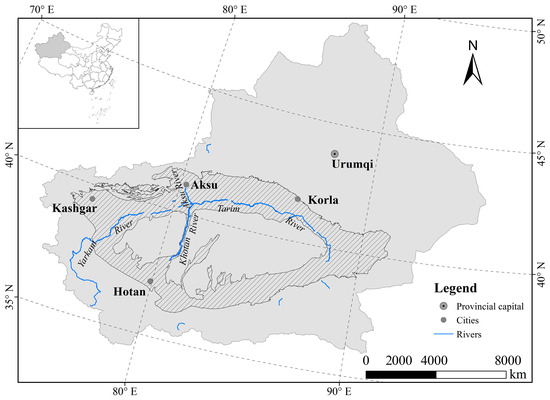
Figure 1.
Location diagram of study area (Projected Coordinate System: Beijing_1954; Projection: Gauss_Kruger).
2.2. Data and Processing
2.2.1. Land Use/Land Cover (LULC) Dataset
An LULC dataset (vector data) was acquired from the Resource and Environment Data Center of the Chinese Academy of Sciences (https://www.resdc.cn/), including 7 periods (1990, 1995, 2000, 2005, 2010, 2015 and 2020). In order to facilitate the analysis, this study merged some unimportant land use types according to the characteristics of land use in the study area. The data classification description is in Table 1.

Table 1.
The LULC system.
2.2.2. Remote Sensing Dataset
The remote sensing dataset was sourced from Landsat data products provided by the United States Geological Survey [50,51,52]. Based on Google Earth Engine (GEE) platform, this study used JavaScript to write code to calculate cloud-free remote sensing images [53] during the annual vegetation growth period (April to October) in seven periods (1990, 1995, 2000, 2005, 2010, 2015, and 2020) in the Circum-Tarim Basin.
2.2.3. Drone Data of Sample Site
The recognition results of desertification degree recognition were verified through the analysis of drone images in the sample area. In this study, a total of 109 plots (sample size: 100 × 100 m) were set up in the Aksu River Basin and the Hotan River basin based on certain altitude gradients and spacing from July to September for the years 2021–2023 (Figure 2) based on light and small unmanned aerial vehicles equipped with RGB visible light cameras (DJI Phantom 4 Pro) for orthophoto image acquisition of sample plots [54,55]. Then, all the drone images were taken back to the laboratory to determine the degree of desertification via the visual interpretation method. Based on previous studies [53,56], this study classified the degree of desertification into five types: no desertification, light, moderate, severe, and extremely severe desertification.
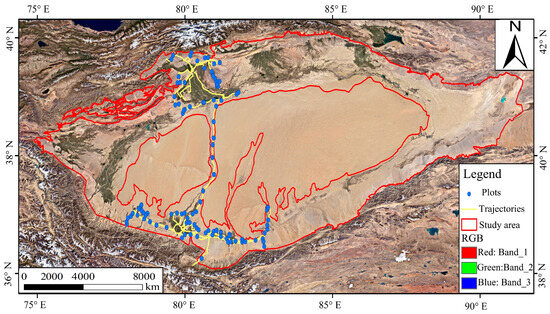
Figure 2.
Unmanned aerial vehicle (UAV) plot location diagram (Projected Coordinate System: Beijing_1954; Projection: Gauss_Kruger).
2.3. Methods
2.3.1. Regional Division of Changes in LULC
The mutual conversion between various LULC types could not only characterize land development activities and socio-economic development in the Circum-Tarim Basin, but also had a close relationship with desertification control. Therefore, in order to clarify the spatial characteristics of LULC changes from 1990, this study defined an area where a certain LULC type had no change in 6 periods as an unchanged region (Region I), and otherwise, it was defined as a changed region (Region II).
2.3.2. Classification and Accuracy Analysis of Desertification Degree
We formulated the desertification classification system in the present study according to the classification standards of existing studies [31,53,57,58]. Desertified land was classified into five levels: no, light, moderate, severe, and extremely severe desertification. The characteristics of the desertified landscapes for each level of desertification are listed in Table 2. The desertification degrees of 109 plots were classified according to this discrimination criterion.

Table 2.
Landscape characteristics of desertification in the Circum-Tarim Basin.
Considering there are currently many classification methods for desertification degree and the classification accuracy is not uniform, this study constructed a Desertification Comprehensive Index (DCI) that could comprehensively express the natural and physical attributes of land for the accurate identification of desertification degree. The index for inverting the natural attributes of land included vegetation coverage (FVC) and a modified soil-adjusted vegetation index (MSAVI). The index for inverting land physical properties included surface albedo (Albedo), land surface temperature (LST), surface soil particle size index (TGSI), and temperature vegetation drought index (TVDI). This study used the Analytic Hierarchy Process (AHP) [59,60] and a 1–9 scale method (Table 3) [59,60,61] to establish a judgment matrix, and the weights of each indicator were determined through consistency testing [62]. On the basis of standardizing the calculation of each indicator, a weighted linear combination method [63] was used to construct DCI (Formula (1)).
where, DCI represents the Desertification Comprehensive Index, is the weight of indicator i, and is the standardized value of indicator i, with a value of 0–1. The standardization methods for each indicator refer to the study by Jiang et al. [31]. As this study focuses on the mutual feedback relationship between LULC and desertification spatiotemporal processes, the evaluation of desertification classification methods and results will be discussed in detail in another article, and only an overview is provided in this study.

Table 3.
Scale method of each remote sensing index.
2.3.3. The Extraction of Spatiotemporal Development Regions of Desertification
Based on the transfer status between different degrees of desertification, this study divided the occurrence and development of desertification into 4 districts: (1) constant district (CA), where a certain type of desertification degree did not change during two periods; (2) degraded district (DE), where desertification degree was transited to lighter degrees; (3) reversal district (RE), where desertification degree was transited to more severe degrees; (4) no-desertification district (NO-District), where there was no desertification. When changes were found to have occurred between adjacent levels, it was considered light degradation (DE1) or light reversion (RE1), while others were considered obvious degradation (DE2) or obvious reversal (RE2). The division standards for each district were as follows (Table 4).

Table 4.
Zoning standards for desertification development.
3. Results
3.1. The Spatio-Temporal Changes in LULC from 1990 to 2020
Tarim Basin is a typical arid area, and the spatial distribution of LULC types is closely related to the distribution of water resources. Farmland and residential–industrial–mining land (abbreviated as residential land) are mainly distributed in oasis areas formed by several major rivers and several distribution areas of the Xinjiang Production and Construction Corps. Grassland is mainly distributed at the edge of oases and on both sides of rivers, while unused land is heavily distributed at the edge of deserts and areas lacking water resources. During the period of 1990–2020, unused land and grassland were the main LULC types in the Circum-Tarim Basin, and the average proportions were 64.69% and 20.61%, respectively, followed by farmland (9.70%) and woodland (3.21%). The water area and the residential land were the smallest ones. In grassland, low-covered grassland (61.79%) comprised the largest area, followed by medium-covered grassland (28.25%), and high-covered grassland (9.96%). Woodland was mainly composed of shrub (20.61%) and spare forest land (35.98%). Residential land was mainly covered by rural areas (62.89%) and urban land (22.82%). Unused land was mainly covered by desert (44.96%), gobi (32.39%), and saline–alkali land (13.74%) (Figure 3).
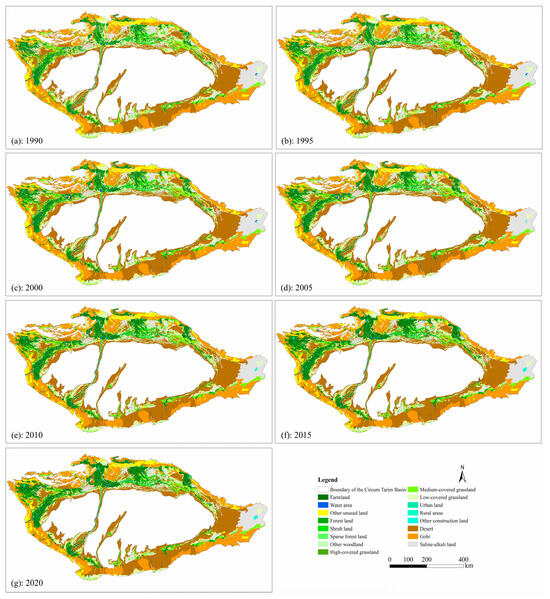
Figure 3.
The distribution of LULC in different periods.
Temporally, farmland increased the most significantly (1.40 × 104 km2) and most obviously (0.23 × 104 km2/5a), followed by residential land (0.09 × 104 km2). Grassland decreased significantly (−1.55 × 104 km2). The reductions in woodland fluctuated, and there was a minor increase in unused land (0.07 × 104 km2). In the second-level types, the types with the greatest reduction were low-covered grassland, medium-covered grassland, saline–alkali land and high-covered grassland, of which low-covered grassland reduced the largest area of 1.0 × 104 km2, accounting for 64.57% of the total reduction area in grassland; medium-covered grassland, accounting for 31.11% (Figure 4).
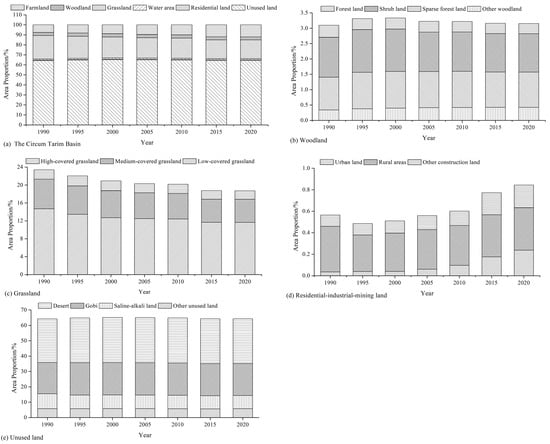
Figure 4.
The composition and changes in area proportion of LULC during the period 1990–2020.
For the transfer situation between different LULC types, the results showed that farmland and residential land were mainly transferred in, while grassland was mainly transferred out (Figure 5). The area transferred to farmland mainly came from grassland (1.22 × 104 km2, accounting for 74.51%), unused land (0.25 × 104 km2, accounting for 15.56%), and woodland (0.11 × 104 km2, accounting for 7.62%) (Figure 5a). In woodland, the sizes of the areas transferred in and out were 0.19 × 104 km2 and 0.18 × 104 km2. Woodland was mainly transferred into farmland (60.59%) and grassland (26.93%) (Figure 5b). Grassland was mainly transferred out to farmland (55.90%) and unused land (33.72%); the types that were transferred in were also mainly unused land (57.70%) and farmland (22.21%) (Figure 5c). Unused land mainly transferred out to grassland (46.04%) and farmland (32.09%), while the type that was transferred in was mainly grassland (89.96%) (Figure 5f). Overall, the increase in farmland was mainly due to the occupation of grassland, unused land, and woodland, especially, the occupation of low-covered grassland, medium-covered grassland, and saline–alkali land.
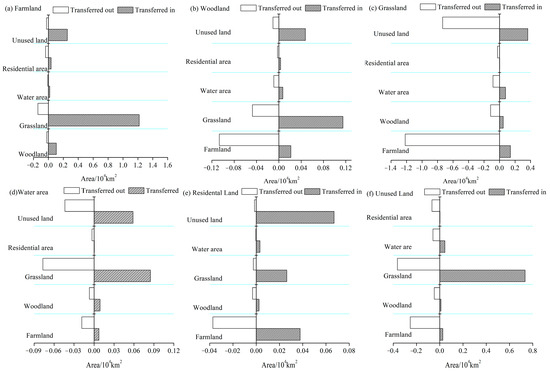
Figure 5.
Accumulated conversion area between land use types from 1990 to 2020.
Spatially, the area with changed LULC types (Region II) was 3.20 × 104 km2, accounting for 9.71% of the total area of Circum-Tarim Basin (Figure 6, Table 5). Region II was mainly distributed on the edge of the oases, riverside, the oasis–desert transition zone, and some areas within oases, where land development mainly occurred. The area of Region I was 29.74 × 104 km2, accounting for 90.29% of the Circum-Tarim Basin, and it was mainly distributed in the early oases and desert areas, where new land development activities were relatively scarce. In Region I, unused land and grassland were still the main LULC types.
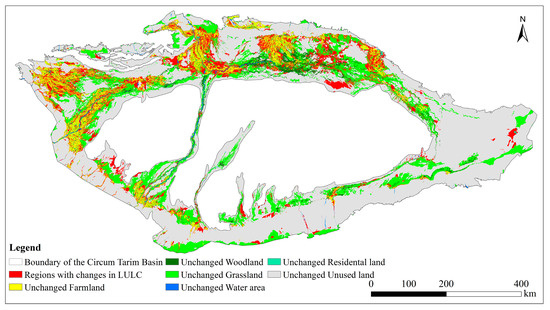
Figure 6.
Overall changes in LULC types in the Circum-Tarim Basin since 1990.

Table 5.
Overall change in area and proportion in LULC types in Circum-Tarim Basin.
In Region II, the characteristics of temporal changes in LULC were the same as those in the Circum-Tarim Basin, but the structure of LULC changed in 2010 (Figure 7). During the period of 1990-2005, the top three types in terms of area were grassland (44.59%), unused land (28.03%), and farmland (19.50%). In 2010, the order changed to farmland (44.18%), unused land (24.54%), and grassland (19.320%), and farmland area continued to increase in 2015 and 2020. This clearly shows that the land development activities in Region II mainly focus on converting grassland and unused land into farmland for agricultural development.
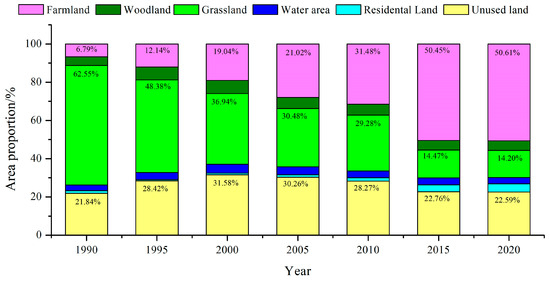
Figure 7.
Changes in the composition of land use types in Region II.
3.2. The Spatio-Temporal Changes in Desertification Degree during the Period of 1990–2020
(1) Accuracy analysis of desertification degree classification
A confusion matrix was constructed between the classification results from Landsat images and the desertification degree samples of the 109 drone images. Then, the accuracy of classification results was evaluated using overall accuracy (OA) and Kappa coefficient. This study used the data from 2020 as an example to evaluate the accuracy of desertification degree classification. The results showed that overall, the accuracy of desertification identification based on DCI was 0.862, the producer accuracy (PA) was 0.897, the user accuracy (UA) was 0.884, and the Kappa coefficient was 0.8, indicating high accuracy (Table 6).

Table 6.
Confusion matrix showing different degrees of desertification identification.
(2) The spatio-temporal changes in desertification degree
On a multi-year average, the total area of desertification land (light, moderate, severe, and extremely severe) was 38.66 × 104 km2, accounting for 90.40% of the total area in the Circum-Tarim Basin, which meant severe desertification phenomenon. No-desertification areas were mainly distributed in oasis areas and on both sides of river trunks, with a concentrated population and good water resource conditions. Light desertification land was mainly distributed within and on the edges of oases and on both sides of some rivers. Moderate desertification land was mainly distributed in oasis–desert transition zones. Severe and extremely severe desertification land were mainly distributed at the edge of deserts and in areas with extremely poor water conditions (Figure 8). The order of area proportion for desertification degree types from largest to smallest was as follows: moderate (32.631%), severe (29.423%), extremely severe (20.879%), and light (7.471%). The no-desertification area was 4.10 × 104 km2 (9.60%). The desertification degree composition in Region I was similar to that of the Circum-Tarim Basin. In Region II, moderate desertification (33.475%) had the highest proportion, but the no-desertification area was relatively large, accounting for 26.387% (Figure 9).
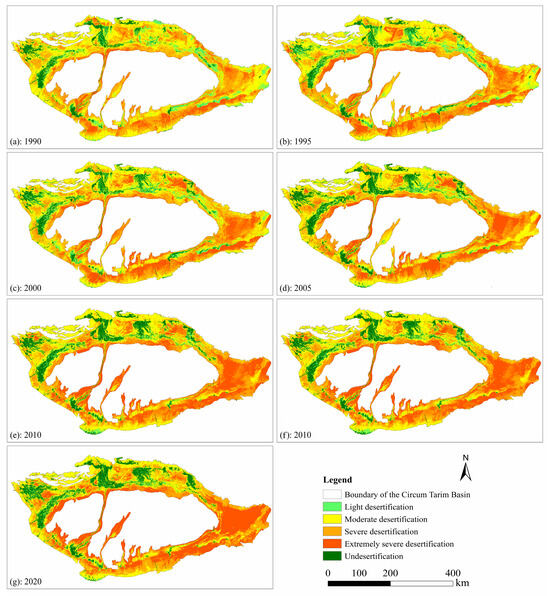
Figure 8.
The spatial distribution of desertification degree in the Circum-Tarim Basin during the period of 1990–2020.

Figure 9.
Temporal variations in desertification degree in the Circum-Tarim Basin.
In the Circum-Tarim Basin, the no-desertification area gradually increased by 2.10 × 104 km2 cumulatively, and the area proportion increased from 6.70% to 11.91%. The desertification area gradually decreased correspondingly. During the period of 1990–2020, the area of light, moderate, and severe desertification decreased by 9.99 × 104 km2 cumulatively; however, the extremely severe desertification area increased by 7.89 × 104 km2. The area size order (from large to small) changed from moderate (38.43%), severe (33.40%), light (16.65%), and extremely severe in 1990 to extremely severe (29.95%), moderate (27.41%), severe (25.65%), and light (16.99%) in 2020 (Figure 9, Table 7). Desertification during the period of 1990–2020 was characterized by an overall improvement and local deterioration, and the internal composition structure of desertification land underwent changes.

Table 7.
Table of statistics for overall development status of desertification in different regions.
In Region I, the no-desertification area increased by 0.71 × 104 km2 cumulatively, and the increase rate was 0.12 × 104 km2/5a. Although the total area of desertification land decreased, extremely severe desertification still increased at a rate of 0.97 × 104 km2/5a. Moreover, the composition of desertification land changed in 2020, with extremely severe desertification becoming the largest area. The desertification in Region I was overall significantly alleviated; however, it intensified significantly in some areas. In Region II, the no-desertification area increased by 0.86 × 104 km2 cumulatively, while the area of extremely severe desertification also increased by 0.10 × 104 km2. For other types, moderate desertification decreased the most (0.64 × 104 km2), and severe (0.23 × 104 km2) and light (0.09 × 104 km2) followed. In Region II, the no-desertification increased at a rate of 0.14 × 104 km2/5a, but extremely severe desertification still increased at a rate of 0.02 × 104 km2/5a. Overall, there was no change in the structure of desertification land, but the proportion of no-desertification and desertification land areas has reversed in order. In 1990, the area of desertification land accounted for 85.95% of the area in Region II, and moderate desertification alone accounted for 44.77%. After the prevention and control measures conducted over the 30-year study period, the no-desertification area proportion (41.45%) leaped to the top of all types.
In the Circum-Tarim Basin, a total area of 2.10 × 104 km2 was converted from desertification into no-desertification land, of which 1.14 × 104 km2 (54.42%) occurred in Region II and 0.96 × 104 km2 (45.58%) occurred in Region I (Table 7). It was indicated that there was a cumulative increase of 7.89 × 104 km2 in extremely severe desertification, of which 7.75 × 104 km2 occurred in Region I, accounting for 98.28% of the total increase area. It is clear that, although Region II only accounts for 9.71% of the total basin, it was the area with the best effectiveness in desertification prevention and control over the 30-year study period. In Region I, desertification prevention and control improved overall, but the deterioration in some regions is evident. Although there was no change in land use types in Region I, industrial and agricultural production, as well as social development, led to concentrated water use, exacerbating water scarcity and desertification in some regions.
3.3. The Interaction between Land Use Change and Desertification Development Process from 1990 to 2020
The results showed that the degraded district was mostly distributed at the edge of deserts, in the southern desert areas and eastern areas of the basin, where the surface vegetation coverage was lower and the ecological environment was worse. The reversal district was more concentrated at the edge of oases and on both sides of rivers, where the water conditions were good and the vegetation coverage was high (Figure 10).
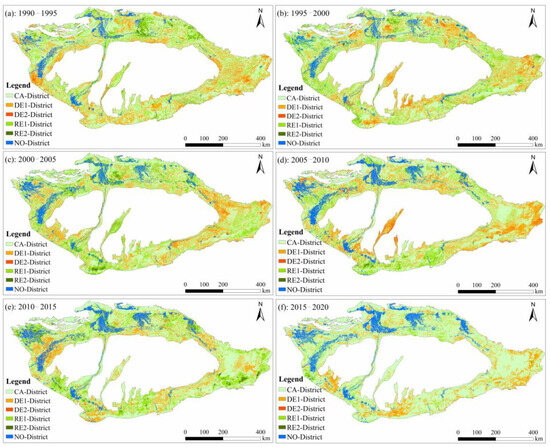
Figure 10.
Distribution of desertification development process in Circum-Tarim Basin.
In the Circum-Tarim Basin, the order of desertification development from large to small was CA (multi-period average 55.49%), DE (20.22%), RE (16.40%), and NO (7.89%). There was little difference in the area proportion between Region I and the basin. In Region II, the area proportion of SA was still the largest one (43.14%), but the area proportions of RE (20.88%) and NO-District (20.45%) became evidently larger. The area proportion of DE was the smallest (15.53%). Overall, the desertification development in the Circum-Tarim Basin presented an overall stable trend, with both degradation and reversion coexisting. There were differences in Region I and Region II; CA and DE dominated in Region I, while CA and RE dominated in Region II, and NO-District accounted for a larger area proportion in Region II than that in Region I (Figure 11). Temporally, the development of desertification in the Circum-Tarim Basin was mainly characterized by an increase in the area of CA and a reduction in the DE and NO-District areas. The area of CA increased by a total of 2.41 × 104 km2, of which 81.46% occurred in Region I, and 18.54% occurred in Region II. The total area of DE decreased by 1.60 × 104 km2, of which 87.34% occurred in Region I, and 12.66% occurred in Region II. The total area of NO-District area decreased by 0.81 × 104 km2, of which 69.88% occurred in Region I, and 30.12% occurred in Region II.
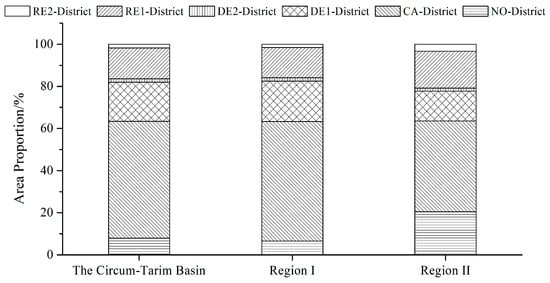
Figure 11.
Changes in the area proportion of desertification development zoning.
The desertification development in the Circum-Tarim Basin was mainly characterized by light degradation and light reversion. The degrees of desertification were mainly shifting towards neighboring lighter degrees. In Region I, the effectiveness of desertification prevention and control was dominated by RE1-3 and RE1-4, but in Region II, it was dominated by RE1-1, RE1-2 and RE1-3 (Figure 12). This could indicate that there were differences in desertification prevention and control in different regions in the Circum-Tarim Basin. In Region I, desertification control mainly focused on the area with the most severe desertification hazards, so the reversal types were those with a higher desertification degree. However, in Region II, which is mainly located in the oasis–desert transition area with good water and vegetation conditions, and where the desertification was relatively mild, the reversal types were mainly moderate, mild, and no desertification.

Figure 12.
The area proportion of different regional areas of desertification development (second level).
This study analyzed the relationship between desertification development and LULC types in Region I (Table 8). The results showed that the reduced area of severe desertification occurred entirely in unused land. Overall, 87.89% of the area of reduced moderate desertification occurred in unused land. However, the increased area of extremely severe desertification also mainly occurred in unused land (91.56%). The reduced area of light desertification mainly occurred in grassland (51.80%), unused land (27.19%) and farmland (14.39%). The increased area of no-desertification mainly occurred in farmland (81.94%) and grassland (20.83%). In Region I, although there were no changes in LULC types, the desertification degree showed reduction and reversal, which meant there was an obvious increase in vegetation cover. In some areas of unused land, there was an obvious decrease in vegetation cover, which led to worsening in the desertification degree to extremely severe desertification. These areas should be the key areas for future desertification prevention and control.

Table 8.
The average change in desertification land area for every land use in Region I (104 km2).
4. Discussion
4.1. The Impact of Changes in Land Use on Desertification Development in the Circum-Tarim Basin
The mode and degree of LULC are dominant factors in desertification development and reversal. The degree of LULC reflects the strength of human activities and is the most sensitive indicator of ecological changes in desert areas [64]. Population growth and the expansion of social demand have increased the pressure on LULC, which may undermine the rationality of traditional land use. The further cultivation of grassland resulted in a sharp decrease in grassland land, with more land changing into farmland and its utilization intensity increasing, the shortening of crop rotation time intervals, and so on. All of the above-mentioned human activities can lead to desertification [64]. The Circum-Tarim Basin is extremely prone to desertification due to its fragile ecological environment, and excessive development and utilization activities further exacerbate the process of soil erosion and desertification [65]. This study showed that there was a close relationship between the development process of desertification and changes in LULC. Since 1990, human activities have changed LULC types and vegetation coverage through land (cultivated land) development, urban construction, and water resource utilization, thereby affecting the occurrence, degree, and direction of desertification in this region.
This study took the Aksu region as an example to analyze the annual value added by the primary industry since 2000 (the data are sourced from the annual national economic development report of the Aksu region). The results showed that the value added by primary industry has increased 10-fold from CNY 4.34 billion in 2020 to CNY 42.12 billion. As a pillar industry of the primary sector, agriculture’s total output value has also increased year by year. The continuous expansion of farmland area, adjustment of planting structure, and introduction of advanced technological experience have all been important guarantees for the positive development of the primary industry. Developing agriculture in arid areas requires a large amount of water resources. In addition, land development, industrial production, and ecological engineering construction have led to significant centralized water use, resulting in insufficient ecological water use in some regions and exacerbating the development of desertification in certain areas.
4.2. The Positive Effects of Ecological Engineering, Afforestation, etc., on Desertification Prevention and Control
In Xinjiang, the fight against sandstorms was destined to be a protracted battle. Now, the sustained efforts have finally ushered in a historic turning point. According to the Sixth National Survey on Desertification and Sandy Desertification, until 2019, the area of desertification and sandy desertification had both decreased. In 1979, China commenced the building of a large-scale long-term forest shelter project—the “Three-North Shelterbelt Program Project”—in areas with severe sand storms and soil erosion, and since its inception, the vegetation cover in Xinjiang has significantly increased. In 2000, the Chinese government launched the Ecological Water Diversion Project (EWDP) to restore the eco-environment of the lower reaches of the Tarim River, with the project costing CNY 1.07 × 1010 [66]. The monitoring data have shown that unreasonable water use leads to a decrease in groundwater level in the lower reaches of the Tarim River, resulting in vegetation degradation and desertification. However, 16 water conveyances in the lower reaches of the Tarim River played a positive role in the uplift of the groundwater level in the lower reaches. Vegetation was effectively restored, and both vegetation coverage and the number of species increased significantly [67,68]. It was shown that from 2001 to 2013, the primary process of land use change in the Tarim River Basin was the transformation from unused land to natural vegetation. The fractional vegetation coverage in 2013 was 1.5 times greater than that in 2001 [1,69]. Moreover, since 2000, various ecological projects have been implemented successively, such as sand prevention and control projects, returning farmland to forests and grasslands projects, etc. For example, in the Aksu region, more than 4.8 million acres of afforestation have been completed based on “5 million acre projects”, such as the “Kekeya Desert Greening Project”, and vegetation cover increased from 3.35% in 1980 to 9.04% in 2022 [26]. In the long-term practice of desertification prevention and control, a number of desertification prevention and control technologies and models that could be used for reference have been summarized, such as the famous sand fixing magic cube “grass grid” sand barrier, the “five-belt integrated” Shapotou railway sand control system, the Kubuqi sand control model, the Kekeya control model, and the Alar control model [26].
All the above-mentioned efforts have indeed changed the land use types to a certain extent. For example, returning farmland to forests would invert certain farmland to woodland; large-scale grass planting and afforestation and EWDP would invert large areas of bare land into grassland and grassland into woodland. Therefore, the relationship between the changes in land use types caused by policy-driven afforestation and grass planting activities and the changes in desertification land is worth further research in the future.
4.3. Suggestions for Subsequent Desertification Prevention and Control in the Circum-Tarim Basin
The future prevention and control of desertification in the Circum-Tarim Basin require “adapting measures to local conditions, rational planning, zoning policies, precise prevention and control”. According to the results of this study, the basin can be divided into two major primary regions: Region I and Region II. In Region I, according to the distribution of towns and social development status, the region can be roughly divided into three secondary areas: oasis area, oasis–desert transitional zone, and desert edge area. Corresponding prevention and control policies for ecological problems in different regions should be established. For example, in areas with good vegetation changes and oasis areas, land development should be strictly controlled, protective forest renewal and transformation should be strengthened, soil salinization prevention and control should be strengthened, and ecological water use should be guaranteed. However, Region I and Region II were extracted based on an LULC dataset, and the relationship between desertification and LULC was also based on the analysis of scientific data. In the future, further detailed investigation and research will be needed on how to perform zoning and implement policies. It is hoped that the research results of this study can provide certain scientific support for the formulation of relevant decisions.
5. Conclusions
The Circum-Tarim Basin is an arid area with a fragile ecological environment, where the population is also concentrated. Over the 30-year study period, the socio-economic status developed rapidly with a significant increase in population, frequent land development, the expansion of artificial oases, and so on. The results of this study indicate that from 1990 to 2020, the farmland in the Circum-Tarim Basin increased significantly by 1.40 × 104 km2, of which 74.51% came from the occupation of grassland (mainly low-covered and medium-covered grassland), and 15.56% came from the occupation of unused land (mainly saline–alkali land). Desertification showed a general alleviation, but there was local deterioration. The area of no-desertification land has significantly increased (an increase of 2.10 × 104 km2), and the degree of desertification has shifted significantly to adjacent lighter degrees; however the area of extremely severe desertification in certain regions has increased (7.89 × 104 km2).
There was an inseparable relationship between LULC and desertification land development. The impact of human activities on the development of desertification in the basin was very significant. In Region II, there was an increase of around 54.42% in the area of no-desertification land, although the area of Region II was only 9.71% of the Circum-Tarim Basin. Meanwhile, in Region I, there was an approximately 98.28% increase in the area of extremely severe desertification. Evidently, Region II was the region with the best desertification prevention and control effect over the 30-year study period in the Circum-Tarim Basin. However, there was also a general alleviation of desertification in Region II overall. It was inevitable that activities such as land development and oasis expansion in Region II would lead to concentrated water use, resulting in water scarcity in certain areas of Region I, which could not then support the needs of vegetation growth, thus aggravating the degradation. In addition, in recent decades, various ecological protection projects and vegetation restoration measures implemented in the Circum-Tarim Basin have played a positive role in desertification prevention and control, alleviating the desertification degree, and leading to a reduction in the size of the desertification area. All these efforts have indeed changed the type of land use to a certain extent. For example, returning farmland to forests could turn certain farmland into forest land; large-scale grass planting and afforestation, as well as EWDP, would transform large areas of bare land into grassland and grassland into woodland. Therefore, the relationship between the changes in land use types caused by policy-driven afforestation and grass planting activities and the changes in desertification land is worth consideration in the future.
Based on the results of this study, some suggestions for subsequent desertification prevention and control have been proposed: “adapting measures to local conditions, rational planning, zoning policies, precise prevention and control”. Implementing policies in different zones would bring forth clear goals, which would contribute to “precision prevention and control of desertification”. However, in the future, significant and detailed investigation and research on how to conduct zoning and implement relevant policies. It is hoped that the research results of this study can provide certain scientific support for the formulation of relevant decisions.
Author Contributions
X.C.: writing—Data analysis, original draft preparation, M.C. and L.X.: data curation and data production, Y.F. and X.C.: writing—review and editing. All authors have read and agreed to the published version of the manuscript.
Funding
This work was supported by the Third Xinjiang Scientific Expedition and Research Program of the Ministry of Science and Technology (Grant NO. 2021xjkk0304), and Science & Technology Fundamental Resources Investigation Program (Grant NO. 2023FY100703).
Data Availability Statement
All the data are available from the corresponding author upon reasonable request. The data are not publicly available due to privacy restrictions.
Conflicts of Interest
The authors declare no conflict of interest.
References
- Yu, X.; Lei, J.Q.; Gao, X. An over review of desertification in Xinjiang, Northwest China. J. Arid Land 2022, 14, 1181–1195. [Google Scholar] [CrossRef]
- UNCCD. United Nations: Convention to combat desertification in countries experiencing serious drought and/or desertification. particularly in Africa. Int. Leg. Mater. 1994, 33, 1328–1382. [Google Scholar] [CrossRef]
- D’Odorico, P.; Bhattachan, A.; Davis, K.F.; Ravi, S.; Runyan, C.W. Global desertification: Drivers and feedbacks. Adv. Water Resour. 2013, 51, 326–344. [Google Scholar] [CrossRef]
- Schlesinger, W.H.; Reynolds, J.F.; Cunningham, G.L.; Schlesinger, W.H.; Reynolds, J.F.; Cunningham, G.L.; Huenneke, L.F.; Jarrell, W.M.; Virginia, R.A. Biological feedbacks in global desertification. Science 1990, 247, 1043–1048. [Google Scholar] [CrossRef] [PubMed]
- Rengasamy, P. World salinization with emphasis on Australia. J. Exp. Bot. 2006, 57, 1017–1023. [Google Scholar] [CrossRef] [PubMed]
- Simon, T. Gradients in vegetation cover, structure and species richness of Nama-Karoo shrublands in relation to distance from livestock watering points. J. Appl. Ecol. 2006, 43, 293–304. [Google Scholar]
- Puigdefabregas, J.; Mendizabal, T. Perspectives on desertification: Western Mediterranean. J. Arid Environ. 1998, 39, 224. [Google Scholar] [CrossRef]
- Garcia Latorre, J.; Sanchez-Picon, A. Dealing with aridity: Socio-economic structures and environmental changes in an arid Mediterranean region. Land Use Policy 2001, 18, 53–64. [Google Scholar] [CrossRef]
- Millennium Ecosystem Assessment. Ecosystems and Human Well-Being: Desertification Synthesis; World Resources Institute: Washington, DC, USA, 2005. [Google Scholar]
- UNCCD. Zero Net Land Degradation: A Sustainable Development Goal for Rio+20; UNCCD Secretariat Policy Brief; UNCCD: Bonn, Germany, 2012; Volume 5. [Google Scholar]
- Reed, M.S.; Stringer, L.C.; Dougill, A.J.; Perkins, J.S.; Atlhopheng, J.R.; Mulale, K.; Favretto, N. Reorienting land degradation towards sustainable land management: Linking sustainable livelihoods with ecosystem services in rangeland systems. J. Environ. Manag. 2015, 151, 472–485. [Google Scholar] [CrossRef]
- Wang, T.; Wu, W.; Xue, X.; Sun, Q.W.; Zhang, W.M.; Han, Z.W. Spatial-temporal Changes of Sandy Desertified Land During Last 5 Decades in Northern China. Acta Geogr. Sin. 2004, 59, 203–212. (In Chinese) [Google Scholar]
- Ryder, J.M. Geomorphological Processes in the Alpine Areas of Canada: The Effects of Climate Change and Their Impacts on Human Activities; Geological Survey of Canada: Ottawa, ON, Canada, 1998.
- Su, X.L.; Kang, S.Z.; Wei, X.M.; Xing, D.W.; Cao, H.X. Impact of climate change and human activity on the runoff of Wei River basin to the Yellow River. J. Northwest A F Univ. 2007, 35, 153–159. (In Chinese) [Google Scholar]
- Huong, H.L.; Thanh, S.N. Response of Streamflow and Soil Erosion to Climate Change and Human Activities in Nam Rom River Basin, Northwest of Vietnam. Environ. Nat. Resour. J. 2020, 18, 411–423. [Google Scholar] [CrossRef]
- Webb, J.L. How Insects Affect the Rice Crop; USDA Farmers Bulletins; UNT Digital Library: Denton, TX, USA, 1920. [Google Scholar]
- Meyer, W.B.; Turner, B.L. Changes in Land Use and Land Cover; A Global Perspective; Cambridge University Press: Cambridge, UK, 1994. [Google Scholar]
- IGBP/IHDP. Land Use and Land Cover Change Science/Research Plan; IGB Report; IGBP: Stockholm, Sweden, 1995. [Google Scholar]
- Tuener, I.B.L. Local faces, global flow: The role of land use and land cover in global environmental change. Land Degrad. Dev. 1994, 5, 71–78. [Google Scholar]
- Wijitkosum, S. The impact of land use and spatial changes on desertification risk in degraded areas in Thailand. Sustain. Environ. Res. 2016, 26, 84–92. [Google Scholar] [CrossRef]
- Kempf, M. Monitoring landcover change and desertification processes in northern China and Mongolia using historical written sources and vegetation indices. Copernic. GmbH 2021, 2021, 1–29. [Google Scholar] [CrossRef]
- Wang, T.; Wu, W. Landuse and sandy desertification in Northern China. J. Nat. Res. 1999, 14, 355–358. (In Chinese) [Google Scholar]
- Salvati, L.; Angelis, A.D.; Bajocco, S.; Ferrara, A.; Barone, P.M. Desertification Risk, Long-Term Land-Use Changes and Environmental Resilience: A Case Study in Basilicata, Italy. Scott. Geogr. J. 2013, 129, 85–99. [Google Scholar] [CrossRef]
- Hawlena, D.; Bouskila, A. Land management practices for combating desertification cause species replacement of desert lizards. J. Appl. Ecol. 2010, 43, 701–709. [Google Scholar] [CrossRef]
- Qi, H.C.; Gao, X.; Lei, J.Q.; Meng, X.Y.; Hu, Z.H. Transforming desertification patterns in Asia: Evaluating trends, drivers, and climate change impacts from 1990 to 2022. Ecol. Indic. 2024, 161, 111948. [Google Scholar] [CrossRef]
- Lu, Q.; Cui, G. Looking at China’s Desertification Prevention and Control; China Forestry Publishing House: Beijing, China, 2023. (In Chinese) [Google Scholar]
- Wang, T.; Yan, C.Z.; Song, X.; Xie, J.L. Monitoring recent trends in the area of aeolian desertified land using Landsat images in China’s Xinjiang region. ISPRS J. Photogramm. Remote Sens. 2012, 68, 184–190. [Google Scholar] [CrossRef]
- Zhu, Z.D.; Liu, S.; Di, X.M. Desertification and Its Control in China; Science Press: Beijing, China, 1989; pp. 27–42. (In Chinese) [Google Scholar]
- Wang, T.; Liu, S.L. Regionalization for Regulating Oasification and Desertification in the Arid Regions of China: A program. J. Desert Res. 2013, 33, 959–966. [Google Scholar]
- Wang, F.; Wu, Z.P.; Wang, Y. Dynamic monitoring of desertification in the Tarim Basin based on RS and GIS techniques. Chin. J. Ecol. 2017, 36, 1029–1037. (In Chinese) [Google Scholar]
- Jiang, L.L.; Jiapaer, G.; Bao, A.M.; Kurban, A.; Guo, H.; Zheng, G.; De Maeyer, P. Monitoring the long-term desertification process and assessing the relative roles of its drivers in Central Asia. Ecol. Indic. 2019, 104, 195–208. [Google Scholar] [CrossRef]
- Wang, R.H.; Zhou, X.J.; Zhang, H.Z. The land desertification disaster in Xinjiang and its countermeasures. J. Nanjing For. Univ. 2002, 26, 32–36. (In Chinese) [Google Scholar]
- Ding, J.L.; Tashpolat, T.; Xiong, H.G. Study of Oasis Desertification Dynamic Change in the South of Tarim Basin. J. Remote Sens. 2002, 6, 56–62+82. [Google Scholar]
- Amuti, T.; Luo, G. Analysis of land cover change and its driving forces in a desert oasis landscape of Xinjiang, northwest China. Solid Earth 2014, 5, 1071–1085. [Google Scholar] [CrossRef]
- Zu, R.P.; Gao, Q.Z.; Qian, J.; Yang, J.P. Environmental changes of oases at southern margin of Tarim Basin, China. Envir. Geol. 2001, 44, 639–644. (In Chinese) [Google Scholar] [CrossRef]
- Zhu, Z.D. Status and Trend of Desertification in Northern China. J. Desert Res. 1985, 5, 3–11. (In Chinese) [Google Scholar]
- Zheng, F.M.; Jia, Z.F.; Liang, F.; Ma, X. Soil salinization in Xinjiang Production and Construction Corps: Current situation and prevention and control countermeasures. J. Agric. 2020, 10, 36–41. (In Chinese) [Google Scholar]
- Gong, X.M. Spatial and Temporal Variation Characteristics and Driving Factors of Land Desertification in Xinjiang. Ph.D. Thesis, Xinjiang University, Urumqi, China, 2007. (In Chinese). [Google Scholar]
- Chen, Y.N.; Li, W.H.; Xu, H.L.; Liu, J.Z.; Zhang, H.F.; Chen, Y.P. The influence of groundwater on vegetation in the lower reaches of Tarim River, China. Acta Geogr. Sin. 2003, 58, 542–549. (In Chinese) [Google Scholar]
- Jiang, L.W.; Tong, Y.F.; Zhao, Z.J.; Li, T.H.; Liao, J.H. Water resources, land exploration and population dynamics in arid areas—The case of the Tarim River basin in Xinjiang of China. Popul. Environ. 2005, 26, 471–503. [Google Scholar]
- Zhang, H.; Wu, J.W.; Zheng, Q.H.; Yu, Y.J. A preliminary study of oasis evolution in the Tarim Basin, Xinjiang, China. J. Arid Environ. 2003, 55, 545–553. [Google Scholar]
- Wang, L.B.; Liu, Q. Quantitative analysis and research on driving factors of desertification in typical areas of Xinjiang. Surv. Sci. Technol. 2011, 3, 19–22. (In Chinese) [Google Scholar]
- Peng, J.; Biswas, A.; Jiang, Q.S.; Zhao, R.Y.; Hu, J.; Hu, B.F.; Shi, Z. Estimating soil salinity from remote sensing and terrain data in southern Xinjiang Province, China. Geoderma 2019, 337, 1309–1319. [Google Scholar] [CrossRef]
- Ye, M.; Xu, H.L.; Song, Y.D. Eco-water conveyances applied to control desertification at the lower reaches of the Tarim River. J. Geogr. Sci. 2005, 15, 360–366. [Google Scholar] [CrossRef]
- Xia, X.H. Desertification and Sandstorm Disaster Control in Xinjiang; Science Press: Beijing, China, 1991. [Google Scholar]
- Xue, J.G.; Dong, W.L.; Sun, J.Q.; Zeng, H.W.; Mao, F.J.; Jin, D.L.; Yi, Q.L. Oasification: An unable evasive process in fighting against desertification for the sustainable development of arid and semiarid regions of China. Catena 2019, 179, 197–209. [Google Scholar] [CrossRef]
- Li, X.Y.; Wan, L.X.; Zhang, Y.S.; Ma, Y.Y. Contribution Degrees of the Desertification Driving Factors of the Green Corridor in the Lower of Tarim River Watershed—Based on the Model of Projection Pursuit Regression. J. Arid Land Res. Environ. 2004, 18, 44–49. (In Chinese) [Google Scholar]
- Xing, Y.J. The Study on Dynmic Change and Driving Factors of Land Desertification Based on “RS” Techniques—Taking Jing He County of Xin Jiang as Example; Xinjiang Normal University: Urumqi, China, 2006. (In Chinese) [Google Scholar]
- Hou, Y.F.; Chen, Y.N.; Li, Z.; Li, Y.P.; Sun, F.; Zhang, S.; Wang, C.; Feng, M.F. Land Use Dynamic Changes in an Arid Inland River Basin Based on Multi-Scenario Simulation. Remote Sens. 2022, 14, 2797. [Google Scholar] [CrossRef]
- Zhang, C.L.; Li, Q.; Shen, Y.P.; Zhou, N.; Wang, X.S.; Li, J.; Jia, W.R. Monitoring of aeolian desertification on the Qinghai-Tibet Plateau from the 1970s to 2015 using Landsat images. Sci. Total Environ. 2018, 619, 1648–1659. [Google Scholar] [CrossRef]
- Earth Resources Observation and Science (EROS) Center. Collection-2 Landsat 7 Enhanced Thematic Mapper Plus (ETM+) Level-2 Science Products; U.S. Geological Survey: Reston, VA, USA, 1999.
- Guo, B.; Zang, W.Q.; Han, B.M.; Yang, F.; Luo, W.; He, T.L.; Fan, Y.W.; Yang, X.; Chen, S.T. Dynamic monitoring of desertification in Naiman Banner based on feature space models with typical surface parameters derived from LANDSAT images. Land Degrad. Dev. 2020, 31, 1573–1592. [Google Scholar] [CrossRef]
- Na, R.; Du, H.; Na, L.; Shan, Y.; He, H.S.; Wu, Z.; Zong, S.; Yang, Y.; Huang, L. Spatiotemporal changes in the Aeolian desertification of Hulunbuir Grassland and its driving factors in China during 1980–2015. Catena 2019, 182, 104123–104133. [Google Scholar] [CrossRef]
- Yi, S. FragMAP: A tool for long-term and cooperative monitoring and analysis of small-scale habitat fragmentation using an unmanned aerial vehicle. Int. J. Remote Sens. 2017, 38, 2686–2697. [Google Scholar] [CrossRef]
- Li, Z.P.; Ding, J.; Zhang, H.Y.; Feng, Y.M. Classifying Individual Shrub Species in UAV Images—A Case Study of the Gobi Region of Northwest China. Remote Sens. 2021, 13, 4995. [Google Scholar] [CrossRef]
- Li, Z.P.; Cao, X.M.; Ding, J.; Feng, Y.M. Annual Desertification during 2001–2017 in China Based on MODIS Satellite Images. J. Desert Res. 2019, 39, 135–140. (In Chinese) [Google Scholar]
- Duan, H.C.; Wang, T.; Xue, X.; Yan, C.Z. Dynamic monitoring of aeolian desertification based on multiple indicators in Horqin Sandy Land, China. Sci. Total Environ. 2019, 650, 2374–2388. [Google Scholar] [CrossRef]
- Han, Z.W.; Wang, T.; Yan, C.Z.; Liu, Y.B.; Liu, L.C.; Li, A.M.; Du, H.Q. Change trends for desertified lands in the Horqin Sandy Land at the beginning of the twenty-first century. Environ. Earth Sci. 2010, 59, 1749–1757. [Google Scholar] [CrossRef]
- Xu, X.M. Application of Analytic Hierarchy Process. Stat. Decis. 2008, 1, 156–158. (In Chinese) [Google Scholar]
- Saaty, T.L. Theory and Applications of the Analytic Network Process: Decision Making with Benefits, Opportunities, Costs, and Risks; RWS Publications: Pittsburgh, PA, USA, 2005. [Google Scholar]
- Zhao, H.C. Analytic Hierarchy Process; Science Press: Beijing, China, 1986. (In Chinese) [Google Scholar]
- Feng, Y.M.; Zhang, H.J.; Lu, Q.; Liang, J.; Zhang, X.Y. Quantification of Suitability Distribution Region of Bursaphelenchus xylophilus in China. Sci. Silvae Sin. 2009, 45, 65–71. (In Chinese) [Google Scholar]
- Wang, X.D.; Zhong, X.H.; Liu, S.Z.; Liu, J.G.; Wang, Z.Y.; Li, M.H. Regional assessment of environmental vulnerability in the Tibetan Plateau: Development and application of a new method. J. Arid Environ. 2008, 72, 1929–1939. [Google Scholar] [CrossRef]
- Hao, C.Y.; Wu, S.H.; Yang, Q.Y. Research on Relationship bet ween Sandy Desertif ication and Land use in Mu Us Region. J. Desert Res. 2005, 25, 33–39. [Google Scholar]
- Liu, T.; Fang, H.; Willems, P.; Bao, A.M.; Chen, X.; Veroustraete, F.; Dong, Q.H. On the relationship between historical land-use change and water availability: The case of the lower Tarim River region in northwestern China. Hydrol. Process. 2013, 27, 251–261. [Google Scholar] [CrossRef]
- Zhou, H.H.; Chen, Y.N.; Li, W.H. Species diversity and dominance population distribution pattern in oasis-desert ecotone. J. Desert Res. 2009, 29, 688–696. (In Chinese) [Google Scholar]
- Xu, H.L.; Chen, Y.N.; Lei, J.Q. Effect of returning river water on sandy desertification reversion at lower reaches of Tarim River. J. Desert Res. 2004, 24, 173–176. (In Chinese) [Google Scholar]
- Zhang, S.; Wang, Y.; Xia, T.T.; Chang, T.T.; Li, Z. Effects of land use/cover change on ecosystem service value under the ecological water conveyance of Tarim River. Arid Land Geogr. 2021, 44, 740–749. [Google Scholar]
- Bao, A.M.; Huang, Y.; Ma, Y.G.; Guo, H.; Wang, Y.Q. Assessing the effect of EWDP on vegetation restoration by remote sensing in the lower reaches of Tarim River. Ecol. Indic. 2017, 74, 261–275. [Google Scholar] [CrossRef]
Disclaimer/Publisher’s Note: The statements, opinions and data contained in all publications are solely those of the individual author(s) and contributor(s) and not of MDPI and/or the editor(s). MDPI and/or the editor(s) disclaim responsibility for any injury to people or property resulting from any ideas, methods, instructions or products referred to in the content. |
© 2024 by the authors. Licensee MDPI, Basel, Switzerland. This article is an open access article distributed under the terms and conditions of the Creative Commons Attribution (CC BY) license (https://creativecommons.org/licenses/by/4.0/).